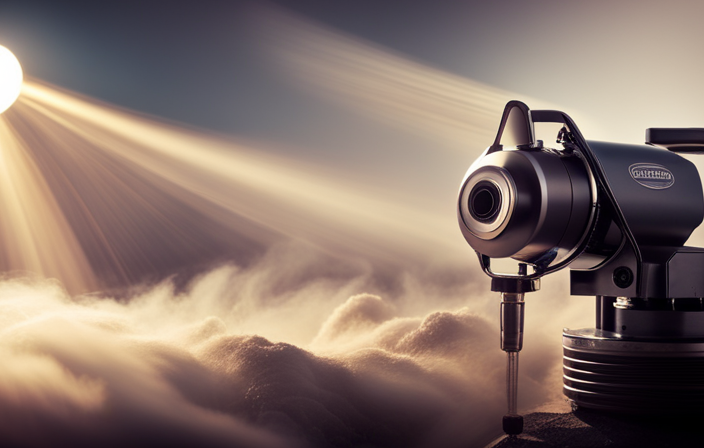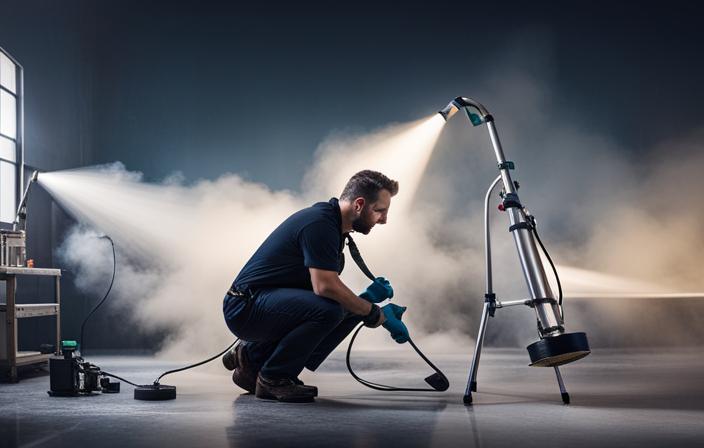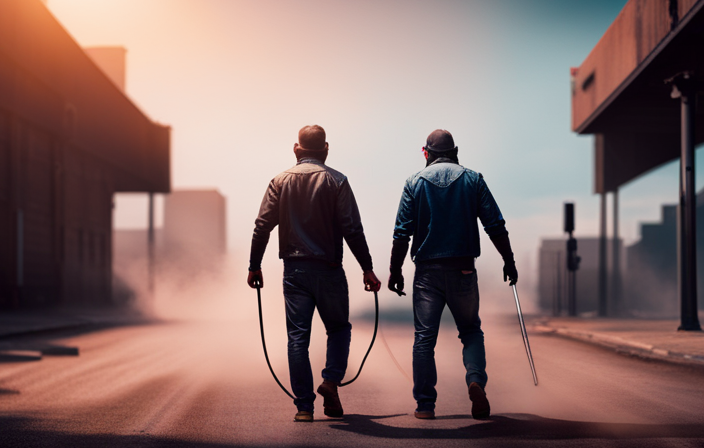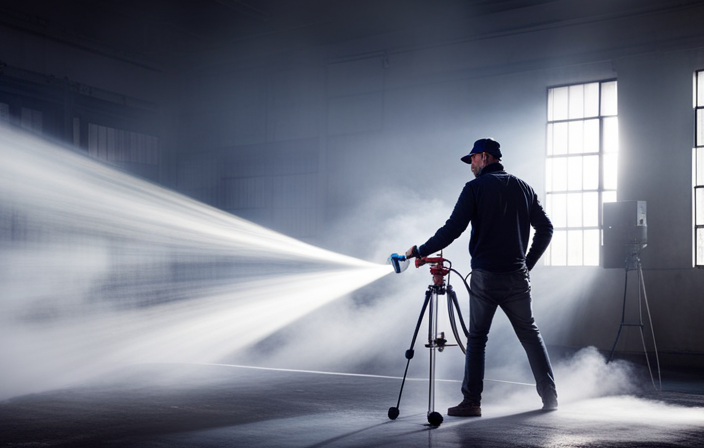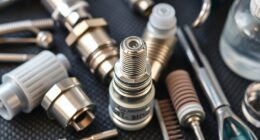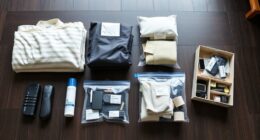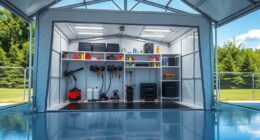Exploring the world of painting, I am mesmerized by the power and efficiency of the airless paint sprayer. It operates like a conductor leading an orchestra, effortlessly orchestrating a symphony of paint particles, transforming surfaces with precision and speed.
An airless paint sprayer, as the name suggests, operates without the need for compressed air. Instead, it utilizes a high-pressure pump to propel paint at a forceful rate, producing a fine mist that evenly coats any desired area. This method ensures a smooth and professional finish, making it a preferred choice for both DIY enthusiasts and professionals alike.
In this article, I will unveil the inner workings of an airless paint sprayer, explore its benefits, discuss various types, offer tips on choosing the right one, and provide maintenance and safety guidelines.
So, let’s embark on this journey together, and unlock the secrets of the airless paint sprayer.
Key Takeaways
- An airless paint sprayer is a tool used for painting that requires regular maintenance and cleaning, including inspecting and cleaning filters, checking spray tip for blockages, and flushing the system with cleaning solution.
- Safety gear, such as goggles, gloves, and a respirator, should be worn when using an airless paint sprayer to protect against paint particles, debris, and harmful fumes and vapors.
- Proper ventilation and workspace setup are essential when using an airless paint sprayer, and the workspace should be organized for efficiency and safety.
- Troubleshooting common issues with an airless paint sprayer, such as no spray or low pressure, uneven spray pattern, or excessive overspray, can often be resolved by cleaning or replacing clogged or damaged parts, adjusting pressure, and cleaning or aligning the spray tip or nozzle.
How Does an Airless Paint Sprayer Work?
Imagine effortlessly transforming your space with the power of an airless paint sprayer, as it flawlessly works its magic to create a smooth and professional finish. Understanding how an airless paint sprayer works is essential for proper maintenance and troubleshooting common problems.
Unlike traditional paint sprayers that use compressed air to propel the paint, an airless paint sprayer uses a high-pressure pump to force the paint out of the nozzle. This results in a more consistent and even application of paint, with no brush marks or streaks. The high-pressure pump also allows for the use of thicker paints and coatings, making it ideal for large projects and textured surfaces.
Transitioning into the benefits of using an airless paint sprayer, it’s important to consider its efficiency and time-saving capabilities.
Benefits of Using an Airless Paint Sprayer
Effortlessly achieve a flawless, professional finish on any surface with the help of this innovative tool. The benefits of using an airless paint sprayer are numerous.
Firstly, it allows for a faster and more efficient painting process. With its high-pressure system, the paint is atomized into tiny droplets, resulting in an even and smooth application.
Additionally, the airless sprayer can handle a wide range of paint materials, from thick latex to thin stains, making it versatile for any project.
Furthermore, it eliminates the need for brushes or rollers, reducing the time and effort required for painting.
The technique involved in using an airless paint sprayer may take some practice to master, but once learned, it provides professional results every time.
With these benefits in mind, let’s now explore the different types of airless paint sprayers available.
Types of Airless Paint Sprayers
The world of airless paint sprayers offers a variety of options, like a palette of brushes, each with its own unique style and application method. When it comes to types of airless paint sprayers, there are three main categories: handheld, stand-mounted, and cart-mounted. Each type has its own set of features that make it suitable for different applications. Handheld sprayers are compact and portable, perfect for smaller projects or touch-ups. Stand-mounted sprayers are more stable and can handle larger areas with ease. Cart-mounted sprayers are the most powerful and efficient, ideal for professional painters or large-scale projects. To help you visualize the differences, take a look at the table below:
| Type | Features |
|---|---|
| Handheld | Portability |
| Stand-mounted | Stability |
| Cart-mounted | Power |
Now that you have an understanding of the types of airless paint sprayers available, let’s move on to choosing the right one for your needs.
Choosing the Right Airless Paint Sprayer for Your Needs
To find the perfect airless paint sprayer for you, it’s important to consider your specific needs and preferences. When choosing the right airless paint sprayer, there are a few key factors to keep in mind.
First, think about the size of the projects you’ll be working on. Smaller sprayers are suitable for smaller tasks, while larger ones are better for bigger jobs.
Additionally, consider the type of paint you’ll be using and make sure the sprayer is compatible with it.
Another important aspect to consider is maintenance and cleaning. Look for a sprayer that is easy to clean and has accessible parts for regular maintenance. Proper care and maintenance will ensure the longevity and efficiency of your sprayer.
Now, let’s move on to preparing for painting with an airless paint sprayer by discussing the necessary steps to get started.
Preparing for Painting with an Airless Paint Sprayer
Getting ready to paint with an airless paint sprayer involves proper preparation and priming the surface. Surface preparation is crucial for achieving a smooth and professional finish.
Before painting, it’s important to clean the surface thoroughly, removing any dirt, dust, or grease. This can be done using a mild detergent and water or a suitable cleaner.
Next, inspect the surface for any imperfections such as cracks or holes, and repair them using a filler or patching compound.
Once the surface is clean and repaired, it’s time to select the right paint for the job. Consider factors such as the type of surface, desired finish, and environmental conditions. Choosing the appropriate paint will ensure optimal adhesion and durability.
Proper techniques for using an airless paint sprayer will be discussed in the next section, providing valuable insights for achieving professional results.
Proper Techniques for Using an Airless Paint Sprayer
When using an airless paint sprayer, it’s crucial to understand the proper techniques for achieving professional results. Two key points to focus on are spray patterns and overlapping strokes. It’s also important to adjust pressure and flow rate. By mastering these techniques, I can ensure an even and smooth paint application. This will result in a flawless finish.
Spray Patterns and Overlapping Strokes
Mastering the art of controlling spray patterns and overlapping strokes is crucial when using an airless paint sprayer, as it allows you to effortlessly achieve professional-looking finishes and flawless coverage. To achieve optimal results, here are three key points to consider:
-
Spray Control: Adjusting the spray pattern width is essential for different surfaces and areas. By narrowing the pattern for detailed work and widening it for larger areas, you can ensure even coverage and minimize overspray.
-
Surface Preparation: Properly preparing the surface before painting is vital for a smooth finish. Ensure it’s clean, dry, and free from any debris or contaminants. Any imperfections should be repaired or smoothed out to avoid blemishes in the final coat.
-
Overlapping Strokes: When spraying, overlapping each stroke by about 50% ensures consistent coverage. This technique prevents unevenness and lines, creating a seamless finish.
Mastering these techniques sets the foundation for achieving professional results. Now, let’s move on to adjusting pressure and flow rate to further enhance your airless paint spraying skills.
Adjusting Pressure and Flow Rate
After understanding the importance of spray patterns and overlapping strokes, let’s now dive into the next crucial aspect of using an airless paint sprayer: adjusting pressure and flow rate.
As a user, it’s essential to have control over these two variables to achieve the desired finish and maximize efficiency. Adjusting the pressure allows you to control the force at which the paint is ejected from the sprayer, ensuring proper coverage and avoiding overspray. Similarly, adjusting the flow rate allows you to regulate the amount of paint being released, preventing wastage and ensuring an even application.
By mastering these adjustments, you can achieve professional-quality results and save time on your painting projects.
Now, let’s explore the maintenance and cleaning of an airless paint sprayer, which is equally important in prolonging its lifespan and maintaining optimal performance.
Maintenance and Cleaning of an Airless Paint Sprayer
To properly maintain and clean your airless paint sprayer, it’s crucial that you regularly inspect and clean the filters to ensure optimal performance. Here are four important steps to follow for maintenance and cleaning:
-
Start by removing the filters and inspecting them for any clogs or debris. Clean them thoroughly using a mild cleaning solution and a soft brush.
-
Check the spray tip for any blockages and clean it using a small wire brush or a specialized tip cleaner. This will help maintain a consistent spray pattern.
-
Flush the paint sprayer system with a cleaning solution recommended by the manufacturer. This will remove any residual paint and prevent it from clogging the system.
-
Lastly, lubricate the moving parts of the sprayer with a suitable lubricant to ensure smooth operation.
By following these cleaning techniques and using the best cleaning solutions, you can keep your airless paint sprayer in top condition.
Now, let’s move on to safety tips when using an airless paint sprayer.
Safety Tips When Using an Airless Paint Sprayer
When using an airless paint sprayer, it’s crucial to prioritize safety. This includes wearing the appropriate protective gear and clothing, such as goggles, gloves, and a respirator, to shield yourself from potential hazards.
Additionally, ensure proper ventilation and set up your workspace correctly. This will help minimize the risk of accidents or exposure to harmful fumes.
Protective Gear and Clothing
Make sure you’re dressed for success when using an airless paint sprayer, by wearing the necessary protective gear and clothing. Safety should always be a top priority when undertaking any painting project. The right gear can make a significant difference in protecting yourself from potential hazards. Here are some important protective gear and clothing options to consider:
| Protective Gear | Clothing Options |
|---|---|
| Safety goggles | Long-sleeved shirts |
| Respirator mask | Pants and socks |
| Nitrile gloves | Closed-toe shoes |
| Hearing protection | Hat or cap |
Wearing safety goggles can shield your eyes from paint particles and debris. A respirator mask will help filter out harmful fumes and vapors. Nitrile gloves provide chemical resistance and protect your hands. Additionally, wearing long-sleeved shirts, pants, socks, closed-toe shoes, and a hat or cap can prevent paint from coming into contact with your skin or hair.
Now that you’re properly dressed, let’s move on to the next section about ventilation and proper workspace setup. It’s important to create an environment that promotes safety and efficiency while using an airless paint sprayer.
Ventilation and Proper Workspace Setup
Now that we’ve covered the importance of protective gear and clothing, let’s move on to ventilation considerations and organizing your workspace when using an airless paint sprayer.
Proper ventilation is crucial to ensure the safety of both yourself and others in the area. Make sure to work in a well-ventilated space or use a ventilation system to remove any fumes or vapors that may be produced during the painting process.
Additionally, it is important to organize your workspace efficiently to maximize productivity and minimize the risk of accidents. Clear any clutter, ensure proper lighting, and set up your equipment in a way that allows for easy access and movement.
By following these ventilation and workspace organization guidelines, you can create a safe and efficient environment for your airless paint spraying tasks.
Now, let’s move on to troubleshooting common issues with an airless paint sprayer.
Troubleshooting Common Issues with an Airless Paint Sprayer
If you’re having trouble with your airless paint sprayer, troubleshooting common issues can feel like untangling a knot of wires. To help you get back on track, here are some troubleshooting tips for common problems you may encounter.
| Problem | Cause | Solution |
|---|---|---|
| No spray or low pressure | Clogged tip or filter | Clean or replace the clogged parts |
| Uneven spray pattern | Worn or damaged tip | Replace the worn or damaged tip |
| Excessive overspray | Incorrect pressure setting | Adjust the pressure to the recommended level |
These are just a few examples of the issues you may face with your airless paint sprayer. Remember to always consult the user manual for specific troubleshooting instructions. In the next section, we will address frequently asked questions about airless paint sprayers.
Frequently Asked Questions about Airless Paint Sprayers
One of the most common questions people have about using an airless paint sprayer is how to troubleshoot common issues. Here are three important tips for maintaining and troubleshooting your airless paint sprayer:
-
Regular Maintenance: To keep your paint sprayer running smoothly, it’s essential to perform regular maintenance. This includes cleaning the filters, inspecting the hoses for any leaks or damages, and lubricating the moving parts.
-
Pressure Problems: If you’re experiencing issues with the pressure of the paint sprayer, check the pressure control knob. Adjust it accordingly to achieve the desired pressure. Also, make sure the spray tip is clean and unclogged.
-
Spray Pattern Issues: If you notice an uneven or spotty spray pattern, check the nozzle for any clogs or debris. Clean it thoroughly and ensure it’s properly aligned and tightened. Adjust the nozzle size if necessary for a more consistent spray pattern.
By following these paint sprayer maintenance and troubleshooting tips, you can ensure optimal performance and achieve professional-looking results with your airless paint sprayer.
Frequently Asked Questions
Can an airless paint sprayer be used for both indoor and outdoor painting projects?
Yes, an airless paint sprayer can be used for both indoor and outdoor painting projects. The high-pressure system allows for efficient and even coverage, making it ideal for large areas. Its versatility and speed make it a preferred choice for professionals.
What safety precautions should I take when using an airless paint sprayer?
When using an airless paint sprayer, proper safety measures must be taken. Protective gear, such as goggles, gloves, and a respirator, is needed to ensure your safety.
Can an airless paint sprayer be used with different types of paint, such as latex or oil-based?
Yes, an airless paint sprayer can be used with different types of paint, including latex and oil-based. The advantages of airless paint sprayers include their ability to handle various paint types efficiently and provide a smooth, even finish.
How long does it typically take to clean and maintain an airless paint sprayer?
Cleaning time and maintenance duration for an airless paint sprayer vary depending on usage and paint type. Generally, it takes around 15-30 minutes to clean the sprayer thoroughly and perform routine maintenance tasks to ensure optimal performance.
Are airless paint sprayers suitable for DIY projects or are they mainly used by professionals?
Airless paint sprayers are versatile tools that are suitable for both DIY projects and professional use. They offer numerous benefits, such as faster and more even paint application, saving time and effort.
Conclusion
In conclusion, the airless paint sprayer is a remarkable tool that revolutionizes the painting process. It’s got a powerful pump and high-pressure system that delivers a precise and even coat of paint, saving both time and effort.
However, it’s important to remember that with great power comes great responsibility. Safety precautions must be taken, and regular maintenance is necessary to ensure the sprayer’s longevity.
So, whether you’re a professional painter or a DIY enthusiast, the airless paint sprayer is a game-changer. It brings efficiency and quality to your painting projects.
